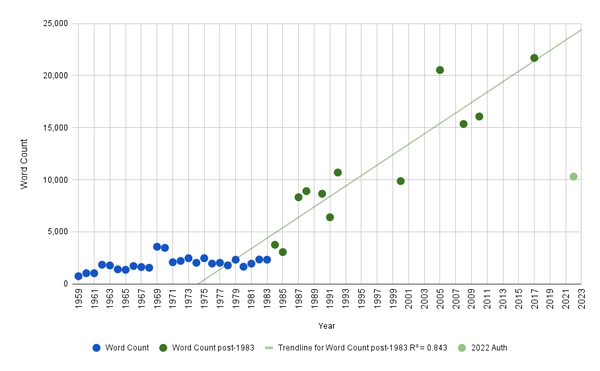Since I was a young child Mars held a special fascination for me. It was so close and yet so faraway. I have never doubted that it once had advanced life and still has remnants of that life now. I am a dedicated member of the Mars Society,Norcal Mars Society National Space Society, Planetary Society, And the SETI Institute. I am a supporter of Explore Mars, Inc. I'm a great admirer of Elon Musk and SpaceX. I have a strong feeling that Space X will send a human to Mars first.
Monday, February 27, 2023
Saturday, February 25, 2023
Friday, February 24, 2023
Wednesday, February 22, 2023
Monday, February 20, 2023
Sunday, February 19, 2023
Saturday, February 18, 2023
Friday, February 17, 2023
Wednesday, February 15, 2023
An Amazing New Discovery About The Milky Way!!!
DISCOVERIES
Wanted: Elbow Room
The Milky Way is no run-of-the-mill galaxy, according to a new study.
A team of astronomers recently discovered that our spiral-shaped home galaxy is actually too big for its surroundings, Science Alert reported.
The Milky Way is located in a “neighborhood” called the Local Sheet, which is a flat arrangement of galaxies that share similar velocities and are surrounded by empty space called voids.
The team explained that the Local Sheet serves as an example of a cosmological wall and separates the Local Void from the Southern Void. The relationship between the galaxies in the Local Sheet has a strong influence on their behavior, such as their similar velocities relative to the expansion of the Universe.
But the Milky Way appears to be an exception.
In their paper, researchers conducted an analysis using simulations from a project called IllustrisTNG, which models the physical Universe.
They found that, being a billion light years across and containing millions of galaxies, very few galaxies located within a cosmological wall structure are as big as the Milky Way.
The study underscores the importance of considering the local environment when studying our home galaxy, rather than assuming that it is in an average spot in the universe.
The environmental context could also help explain some previously unexplained phenomena, such as the odd arrangement of satellite galaxies around Andromeda and the peculiar lack of them around the Milky Way.
Tuesday, February 14, 2023
The US Space Force-Finding Its Way
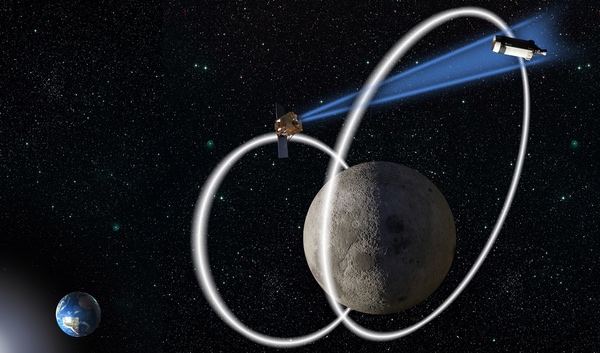 The Space Force is studying new initiatives, like tracking objects in cislunar space, even as there are gaps in its existing capabilities. (credit: AFRL) |
Galactic dissonance for the Space Force
by Matthew Jenkins
Monday, February 13, 2023
In the early days of airpower, foresighted theorists like Billy Mitchell petitioned hard to demonstrate the value that airpower could bring to the warfighting abilities of the United States. Ardently campaigning, Mitchell got permission from Congress to illustrate this capability when in July 1921, his airmen sank the captured German ship Ostfriesland. It was, without question, a defining moment in the infancy of airpower that would pave the way for the eventual creation of an independent Air Force.
| The problem is that it has not figured out how it looks different than what the Air Force did for many years or, more importantly, how to highlight that new value. |
Fast forward to the nascent Space Force, and it feels like the newest military service is lost somewhere between trying to do what the Air Force Space Command always did—and did well, mind you—and trying to chart its unique path with new uniforms and a song. It is no wonder Congress is confused and annoyed.
Looking at their recent efforts, one can’t help but feel like they’re watching a toddler claim adamantly that everything they see and touch is “theirs,” yet there appears to be no understanding of other claimants or geopolitics. There is an even greater feeling that the Space Force is looking for its own Ostfriesland moment. The problem is that it has not figured out how it looks different than what the Air Force did for many years or, more importantly, how to highlight that new value to Congress, the taxpayers, or even the other services of the United States.
The Space Force has a critical mission. It starts with continuing to enable the terrestrial fight, and then it moves to defending US orbital assets. This begins with space-enabled warfighting capabilities, something the Air Force and the intelligence community have long done well. Then, the mission moves to space situational awareness (SSA) capacity to inform space domain awareness. The United States has some SSA capabilities, but it is fair to say we haven’t yet perfected them. We have capability gaps we desperately need to solve to enable our ability to fight through a conflict. However, the Space Force’s effort to “do new” has led them to look past these gaps and instead begin studying SSA requirements for cislunar space.
To be clear, this is not the same problem but an exponentially more difficult one. Cislunar SSA is made more complicated by the technological challenges of a mission 400,000 kilometers away. Bandwidth and communication relays become key drivers in what you can and can’t do while orbiting the Moon.
The natural question is, why the United States is doing it? The short answer is because China did it. China put a vehicle in cislunar space that talks to its lunar rover. Some believe that China’s operations on the far side of the Moon are troublesome. This fear drives precious U.S. defense spending to address a perceived threat. Whether there actually is a Chinese threat to be worried about is undoubtedly subject to debate. Still, the fact remains that it seems a hard sell to convince taxpayers that we need to have military and warfighting capabilities around the Moon where there are no humans present. Certainly not the Ostfriesland moment the Space Force is looking for.
| The lack of a coherent space strategy leaves the Space Force defining its own mission spaces and grasping at anything and everything it can to show its worth. |
In an effort for the service toddler to grab another toy unclaimed at recess, the Space Force is also aiming to take on a new mission. The Space Force recently awarded contracts to advance the state of active debris removal (ADR). This is a crucial mission area, but it is not one that the military should be doing. Companies like Northrop Grumman’s SpaceLogistics and Astroscale are already charting a course to create ADR capabilities that are not military in nature or intent. In fact, other countries would likely perceive these non-governmental, commercial capabilities as less provocative. In addition, the dual-use conundrum that has vexed the United States (and other countries) for decades would be equally applicable here. Without enhanced standards of conduct and more transparency into what space systems are actually doing and when they’re doing it, having a military capability with the sole function of rendezvous and proximity, along with docking operations, would undoubtedly run the risk of inadvertent escalation. This, presumably, would be the opposite of the desired result. Again, perhaps not the Ostfriesland moment it is looking for.
Finally, the Space Force recently acknowledged that it might be interested in augmenting its orbital assets with commercial assets. As if obfuscating military distinction couldn’t be any more complicated, this seems like another bad idea. If that is the case, the United States must be willing to accept civilian space assets as legitimate military targets and, if called upon, defend them with the same effort as military space assets. While this is not a new challenge, it has garnered greater attention as the US government has subsidized the use of Starlink as Ukrainians fight invading Russians. The Russian government has certainly taken notice.
This isn’t an inditement of the Space Force. It should be expected that, left to its own devices, the newest military service will solidify its existence and purpose. In doing so, growing pains are expected and normal. However, the lack of a coherent space strategy leaves the Space Force defining its own mission spaces and grasping at anything and everything it can to show its worth. The Space Force’s purpose and role in supporting national space policy need to be delineated. Specifically, we need answers about how the Space Force protects American interests at home and abroad by applying spacepower and space-enabled capabilities and services. Once Congress and the taxpayers understand that answer, then the Space Force can understand that as well—then it may well find its Ostfriedland moment.
Matthew Jenkins has more than 17 years of space experience in everything from acquisition, launch, operations, and disposal. He is currently a doctoral candidate at the Institute of World Politics in Washington, DC.
Small Launch Satellite Companies Are Having Big Problems
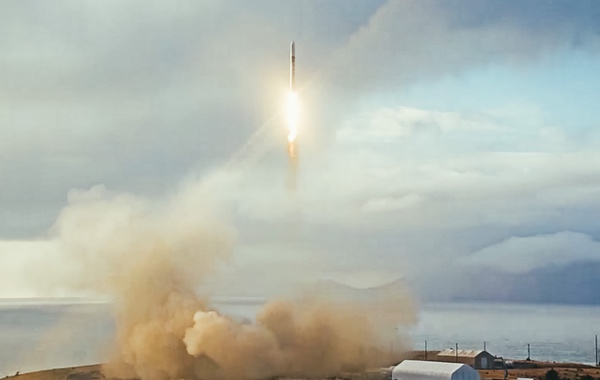 ABL Space Systems launched its first RS1 rocket January 10. Seconds after liftoff, though, the vehicle lost power and crashed in an explosion that damaged its launch pad. (credit: ABL Space Systems) |
Too many or two few? The launch industry’s conundrum
by Jeff Foust
Monday, February 13, 2023
After months of anticipation, the first orbital launch from UK soil took off from Spaceport Cornwall in southwestern England late in the evening of January 9. Virgin Orbit’s “Cosmic Girl” 747 aircraft, with a LauncherOne rocket slung under its left wing, headed out over the Atlantic for its mission. The event attracted a large crowd despite the late hour and the fact that there was little for them to see other than the airplane’s takeoff, since the release of the rocket and its climb to orbit would take place off the coast of southern Ireland, far out of view. (Attendees were entertained by other things, including a “silent disco” where they could dance away to tunes played on wireless headphones.)
| “This is like a $100 part that took us out,” Hart said the component linked to the LauncherOne failure. |
The action was on the mission’s webcast, where viewers could follow the mission, including telemetry from the airplane and rocket. The flight appeared to go like four previous, successful missions over the previous two years, with the rocket separating from the 747 and igniting its first stage engine, followed a few minutes later by stage separation and second stage ignition. The telemetry appeared erratic at times, but the company announced on the webcast and social media that the second stage and its payload of seven smallsats had reached orbit, where they would coast before a second burn more than a half-hour later to circularize the orbit and release the payloads.
“LauncherOne has once again successfully reached Earth orbit! Our mission isn’t over yet, but our congratulations to the people of the UK! This is already the first-ever orbital mission from British soil – an enormous achievement by @spacegovuk and their partners in government!” the company tweeted.
A half-hour later, though, the company retracted that claim and deleted the tweet. “We appear to have an anomaly that has prevented us from reaching orbit. We are evaluating the information,” the company announced. It didn’t explain why it claimed the payload reached orbit, and provided few details about the failure.
A few days later, it said the upper stage suffered an unspecified anomaly that shut down its engine prematurely. The company said is started a formal investigation, which would be jointly overseen by the FAA and the UK’s Air Accidents Investigation Branch.
That investigation is ongoing, Dan Hart, president and CEO of Virgin Orbit, said on a panel Feb. 7 at the SmallSat Symposium in Mountain View, California. However, he said the data investigators had reviewed to date appeared to identify a likely cause involving a relatively inexpensive component in the propulsion system in the rocket’s second stage.
“Everything points to, right now, a filter that was clearly there when we assembled the rocket but was not there as the second stage engine started, meaning it was dislodged and caused mischief downstream,” he said. “This is like a $100 part that took us out.”
He didn’t state when the investigation would be completed, but said Virgin Orbit is already working on modifications, like removing the filter, as it prepares to return to flight from Mojave Air and Space Port in California. “We’re in integration for our next flight and looking forward to flying from Mojave over the coming weeks.”
Virgin Orbit is not the only launch company to have suffered a recent failure. Almost exactly 24 hours after LauncherOne was released from Cosmic Girl, ABL Space Systems launched its first RS1 rocket from Pacific Spaceport Complex Alaska (PSCA) on Kodiak Island. There were no crowds and no silent disco at this event; there was not even a livestream as the company instead provided updates on social media.
About 20 minutes after the scheduled liftoff, ABL announced the mission’s failure. “After liftoff, RS1 experienced an anomaly and shut down prematurely,” the company tweeted. “The team is working through our anomaly response procedures in coordination with PSCA and the FAA.”
A week later, the company released more details about the failed launch, which carried two smallsats. ABL said that at T+10.87 seconds, the first stage suffered a “complete loss of power” that shut down its nine engines. The rocket, less than 250 meters above the pad at the time, continued upward for 2.6 more seconds before falling back to the ground, exploding only about 20 meters from where it lifted off.
| “We’re seeing an abnormally high rate of failures for small launch vehicles,” said Spice. “I don’t think it’s necessarily all that unpredictable when you think about the challenges that have been placed in front of these companies.” |
While the investigation is going, ABL speculated that a fire at the base of the vehicle caused the loss of power, based on telemetry as well as imagery. “Shortly before the power loss, a handful of sensors began dropping out sequentially. This evidence suggests that an unwanted fire spread to our avionics system, causing a system-wide failure,” the company stated.
Like Virgin Orbit, ABL didn’t give an estimate of when it would make its next RS1 launch attempt, but noted both stages of the second vehicle are completed and ready for testing. “Pending the results of our anomaly investigation, we’ll be prepared to share more on the expected timeline for these efforts.”
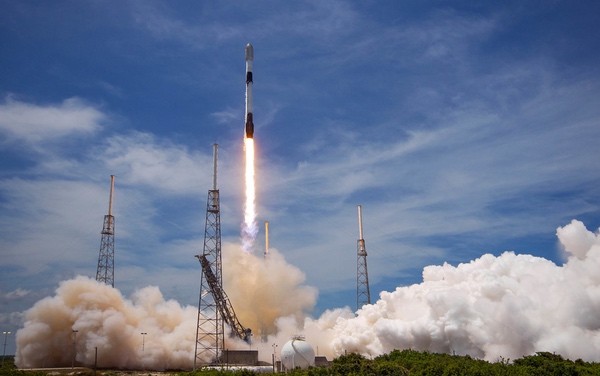 A SpaceX Falcon 9 lifts off last year on the Transporter-5 dedicated smallsat rideshare mission. Those Transporter missions have depressed smallsat launches to the point where others providers argue they cannot make money. (credit: SpaceX) |
“The beginning of the bloodletting”
Those failures and others, including a Vega C lost in a December launch, are signs of stress to some in the industry. “We’re seeing an abnormally high rate of failures for small launch vehicles,” said Adam Spice, CFO of Rocket Lab, on the SmallSat Symposium panel. “I don’t think it’s necessarily all that unpredictable when you think about the challenges that have been placed in front of these companies.”
He and others said small launch vehicle developers are facing pricing pressure from SpaceX. That company operates a series of dedicated smallsat rideshare missions, called Transporter, with the most recent one in early January. SpaceX also offers rideshare space on some of its Starlink launches, such as one in late January that carried a orbital transfer vehicle (OTV) from D-Orbit with several payloads.
Even with price increases announced last year, SpaceX offers list prices typically far below dedicated small launch vehicles: $275,000 for a 50-kilogram smallsat. During a side meeting at last August’s Small Satellite Conference in Utah, Jarrod McLachlan, director of rideshare sales at SpaceX, said all of its Transporter missions in 2023—the company launches three or four a year—were already fully booked and “getting pretty full” for 2024. “We’ve really seen a strong market demand.”
That’s become a problem for small launch vehicle companies. “If we talk about 50 kilograms, 100 kilograms, this kind of satellite size, this is the size of the Transporter missions,” said Marino Fragnito, senior vice president and head of the Vega business unit at Arianespace. “The reference price is the Transporter price. With that price, nobody will make money.”
Even Rocket Lab, among the most successful of the small launch vehicle companies with more than 30 Electron launches, saw the effects of SpaceX on the market. “I think the fact is they’ve suppressed prices in the market. I think the fact is they’ve taken a lot of volume off of the market,” Spice said. “That’s a reset that really wasn’t there in the model even only a few years ago.”
He and others suggested that cost cutting in order to compete with SpaceX threatened reliability. “Delivering a reliable and regular launch service is expensive,” said Giulio Ranzo, CEO of Vega prime contractor Avio. “Pricing needs to take this into account. There is no easy solution to finding a lower price launch service.”
Spice was perhaps the most pessimistic on the panel, citing a combination of the pricing pressure from SpaceX, technical problems, and less access to capital given the state of the industry and broader economy.
“You have a very strong muting function that SpaceX is providing to the small launch market, which I think ultimately will force survival of the fittest,” he said. “I think there will be a lot fewer players out there in a few years than there are today.”
A little later, he was even more blunt. “People underestimate how difficult the launch business really is,” he said. “I think we’re at the beginning of the bloodletting of aspirational launch companies.”
| “There are not enough launch companies. There are not enough launch vehicles available to fill that demand,” said Choi. |
Even non-aspirational launch companies—those that have attempted launches—have suffered problems. Last August, Astra abruptly retired its Rocket 3 vehicle after a string of failures, saying it wanted to focus its resources on the larger Rocket 4. Astra, which went public in 2021 through a special-purpose acquisition company (SPAC) merger, has seen its share price plummet and faces the threat of delisting from Nasdaq.
Virgin Orbit also appears to be in financial straits. The company, which also went public through a SPAC merger at the end of 2021, has seen its cash reserves dwindle. The company has raised $55 million since November through debt offerings with Virgin Investments Ltd., the investment arm of Virgin Group. Those transactions are secured with the Virgin Orbit’s assets, including its 747 aircraft, as collateral.
At the SmallSat panel, Hart didn’t address the company’s financial issues, despite an audience question submitted through an online platform that was upvoted to be one of the most popular.
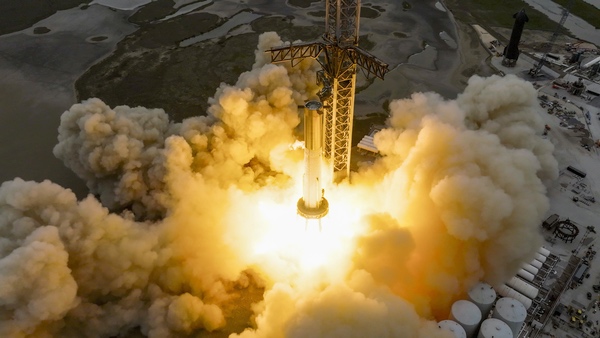 A static-fire test of nearly all the engines in the Super Heavy booster for Starship last week. Starship could further reduce costs and create complications for launch providers. (credit: SpaceX) |
“There are not enough launch companies”
While launch companies raise the specter of a shakeout that would reduce the number of players in the field, some customers are asking for just the opposite: more options for launching their payloads.
“There are not enough launch companies. There are not enough launch vehicles available to fill that demand,” said Tom Choi, chief executive of Saturn Satellite Networks, during a separate panel at the SmallSat Symposium two days later.
While Choi’s company focuses on GEO satellites, building a series that can be launched together on a vehicle like the Falcon 9, he said he sees growing demand for LEO satellites. He claimed the LEO space industry, generating $3–4 billion a year in revenue now, could grow to $30–50 billion in a decade, although he did not cite the source of that analysis.
“I would highly encourage people who are thinking about launch vehicles or people who are already making launch systems to continue to develop their systems,” he said, including vehicles with payload capacities as small as 500 kilograms.
Companies like Spaceflight, which arranges launches of satellites as rideshare payloads on a variety of vehicles, are also looking for additional options. “Right now it’s a little bit thin. It would be very good to have a lot of folks out there,” said Curt Blake in one of his last appearances as CEO of Spaceflight. (The company recently announced he would be stepping down into an advisory role with the hiring of Tiphaine Louradour, former president of International Launch Services, as the new CEO.)
Spaceflight, he said, has tried to support that creation of supply by helping out new launch providers, such as through letters of intent regarding future purchases of launch services. “We can definitively do with more opportunities for launch. We have more demand than we have supply.”
If there really is more demand than supply, why are some launch companies struggling? Some suggested that customers, for now, don’t value dedicated launches enough to pay a premium for them over rideshare services.
“We don’t want to be a low-cost company,” said Raúl Verdú, chief business development officer and co-founder of PLD Space, on the panel. His company is developing a small launch vehicle called the Miura 5, with a suborbital demonstrator, Miura 1, set to make its first launch in the next six to eight weeks.
He said his company values reliability over racing to be the first European small launch vehicle developer to reach orbit. “If you fly with PLD Space, you fly with a premium company, because we are investing a lot in product assurance.”
In the earlier panel, some launch industry executives said they anticipated demand from more sophisticated commercial customers as well as government customers. Bill Weber, CEO of Firefly Aerospace, said his company’s Alpha rocket is attracting interest from customers who don’t feel like Transporter missions are a good fit. “They are saying, ‘Transporter does not work for our mission set.’”
Potential government demand, Fragnito speculated, is a reason why some companies that entered the market with vehicles capable of placing no more than a few hundred kilograms into orbit are developing larger vehicles. “All these companies are trying to grow their launchers to the sweet spot of one ton, 1.5 tons, because there, there is the government business,” he said.
| “If you are not preparing for how you’re going to launch your product on Starship and how you’re going to change your business model to work with Starship, you are going to be in trouble,” said Tripathi. |
But small launch vehicle developers are not the only ones scaling up. Last Thursday, SpaceX performed its biggest static-fire test of its Starship launch vehicle, firing nearly all the 33 engines in the vehicle’s Super Heavy booster on the pad. (One of the engines was shut down just before ignition and a second shut down during the test, CEO Elon Musk tweeted.)
That test is one of the final technical milestones before a first orbital flight test. “It’s really the final ground test that we can do before we light ’em up and go,” Gwynne Shotwell, president of SpaceX, said the day before at the FAA Commercial Space Transportation Conference in Washington. She predicted that launch could take place in a month, pending final technical work and receipt of an FAA launch license.
During another panel at the SmallSat Symposium, one former SpaceX official predicted that Starship could alter the smallsat launch market again, just as the company has already done with Falcon 9 rideshare missions.
“If you are not preparing for how you’re going to launch your product on Starship and how you’re going to change your business model to work with Starship, you are going to be in trouble,” said Abhishek Tripathi, now at the University of California Berkeley’s Space Sciences Laboratory.
Starship, designed to place 100 metric tons or more into low Earth orbit, would seem to be vastly oversized for smallsats, but the low prices it offers could make it attractive to smallsats as rideshares. “If that means that I need to partner with a space tug to get to my final orbit, OK,” he said.
For now, launch companies are coming to grips with challenging competition, but also see positives. “I’ve been in the space business now for almost 30 years,” Fragnito said. “I have never seen so much business. I have never seen so much demand for launches.”
“I’m much more positive than a few years ago on the fact that more companies can survive,” he said. “The ones that will be able to operate successfully a launch system can survive because there is a lot of demand.”
Jeff Foust (jeff@thespacereview.com) is the editor and publisher of The Space Review, and a senior staff writer with SpaceNews. He also operates the Spacetoday.net web site. Views and opinions expressed in this article are those of the author alone.
Note: we are using a new commenting system, which may require you to create a new account.
Trends In NASA Authorization Legislation
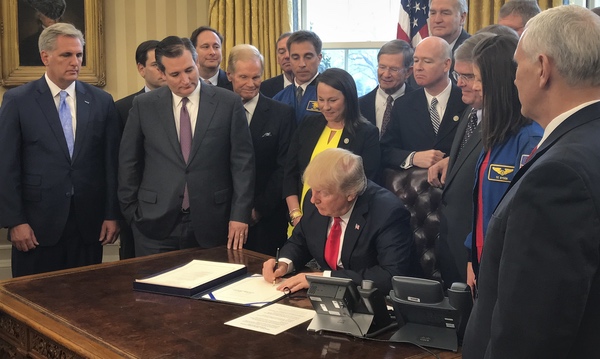 President Trump signs the NASA Transition Authorization Act of 2017, the last standalone NASA bill enacted. A NASA authorization was included as part of the larger CHIPS and Science Act in 2022. (credit: NASA) |
Trends in NASA authorization legislation
by Alex Eastman and Casey Dreier
Monday, February 13, 2023
NASA authorization legislation has become less frequent and grown significantly longer since the early 1980s. This represents a marked departure from the first two decades of NASA’s history, in which Congress passed annual authorizations of consistent length. We suggest that this reflects increasing political polarization in Congress, which reduces the frequency of non-critical legislation. Other factors likely driving growth are the legislative response to disasters, such as the loss of Challenger and Columbia, and the growing scope of the space program itself.
The Planetary Society has published a list of every NASA Authorization legislation passed into law since 1958. It includes high-level summaries, basic information like party control of Congress and date of signage, and links to original source materials. We hope this resource supports further research into trends in congressional policy-setting for the United States’ civil space program.
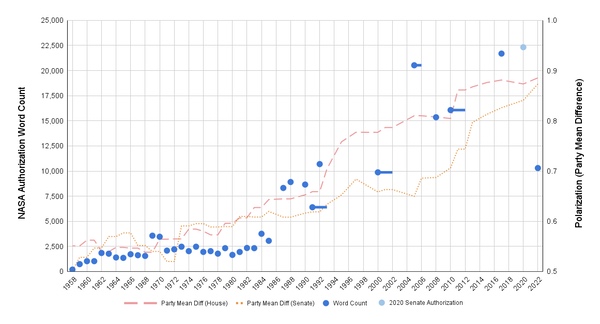 Chart 1. NASA Authorization legislation has, on average, grown in length and decreased in frequency beginning in the mid-1980s, consistent with the increasing polarization of Congress. Lines denote the duration of multi-year authorizations. The outlier in 2022 was the likely result of the NASA authorization’s inclusion within the CHIPS and Science Act. We present the 2020 NASA Authorization, which passed the Senate but not the House, as context. Note how legislative word count grows similarly with congressional polarization, as measured by UCLA’s DW-NOMINATE index. |
Introduction and methods
Congressional authorization legislation is required to “establish, continue, or modify federal programs” and is necessary for the legislative appropriation of funds from the US treasury. NASA authorizations also can establish national policy, new programs, and state findings and “senses of Congress” to guide the implementation of the US civil space program. And though authorizations can detail spending levels for various programs, they are distinct from appropriations, which must occur every year lest they result in an operational shutdown of agencies like NASA. Without an authorization, however, the US space program can function normally.
We had noted the relative dearth of modern authorizations and wondered: is our current pace of legislative action unique or consistent with historical trends?
| The year 1992 can be considered a turning point in the frequency of legislation: since then, there have only been six NASA authorizations signed into law. |
To measure this, we analyzed every NASA authorization ever signed into law. We recorded key policy highlights as they pertained to exploration, planetary science, the search for life, and planetary defense. And we measured both word counts and dates in which legislation were signed into law. Our full list (including source links and notes) is available at The Planetary Society.
Measuring word length is relatively straightforward for modern legislation (one merely highlights relevant sections of legislation and performs a word count), but NASA’s authorizations prior to 2000 exist only as scanned PDF files. We used Apple’s optical character recognition system built into iOS to select to copy out the relevant text from these PDF files. We acknowledge there will be some artifacts and inaccuracies in this process and that the exact word count may vary to a small degree using other approaches. However, we are confident that our analysis is accurate enough within the scope of our needs and given the relative scale (in the thousands to tens of thousands of words) of the source documents.
Analysis
Between 1958 to 1985, Congress passed without fail annual NASA authorizations. Between 1986 and 1992, Congress passed annual NASA authorizations except for the notable years of 1986 and 1989. The first example of a multi-year authorization was signed into law in 1991, though it only specified NASA’s topline for two future years and was replaced by a new authorization the following year.
The year 1992 can be considered a turning point in the frequency of legislation: since then, there have only been six NASA authorizations signed into law. And though three of these were multi-year authorizations, the number of years NASA has gone without congressional authorization is much greater than in prior decades (Chart 2).
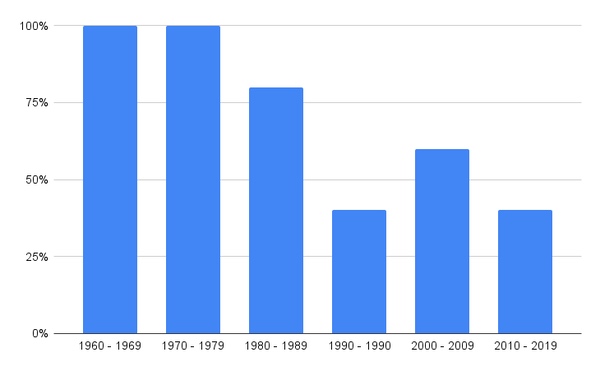 Chart 2. The percentage of a decade in which NASA appropriations were explicitly authorized. This chart takes into account the multi-year authorizations in the 1992, 2000, 2005, and 2010 acts. |
Regarding length, from 1958 to 1982, authorizations tended to be terse, around 1,900 words. Their focus was on line-item program authorizations. However, beginning in 1983 the average length began trending sharply upward, with the last standalone legislation clocking in at nearly 22,000 words in 2017 (Chart 3). The 2022 NASA authorization is a notable outlier, coming in at half the length of the previous legislation; we note that it was included within another bill and was likely pared down as a result. The 2020 standalone NASA Authorization, passed by the Senate but not the House, clocks in at 22,000 words and fits nicely on the modern our growth trendline.
Why the growth? One explanation is that NASA just does more than it used to. To some degree, this is true: NASA has grown to include sustained Earth science, biological and physical sciences, technology development, and planetary defense activities. It simultaneously manages a sustained human presence in low-Earth orbit while preparing for a return to the Moon. But we note that changes in NASA’s activities in the past do not correlate with legislative word count. 2005’s authorization, which kickstarted the Constellation program, is the second-longest legislation on record, but the start of the Space Shuttle program or the Vision for Space Exploration saw no similar bump in size. Similarly, NASA’s 1985 authorization dedicated just 109 words to the project that would become the International Space Station. Additionally, the most ambitious and rapid development period of NASA’s history—the Apollo era—regularly saw authorizations ten times smaller than modern legislation.
The nature of the authorizations has itself changed. In the annual legislation era through the 1980s, bills were mostly focused on line-item fiscal allotments. Modern legislation tends to be much more focused on policy issues, authorizing a handful of topline authorizing amounts equal to those already appropriated. The increase in policy prescriptiveness accounts for much of the content of the growth, though not necessarily the reasons behind it.
| Prior to 1994, Congress had missed just three authorizations over the previous 21 years. Since then, they have passed only six. |
We should note that the two largest relative increases in legislative length correlate with both Shuttle disasters. The NASA Authorization Act of 1988 is 171% (nearly three times) longer than the 1986 authorization passed prior to the loss of the Challenger. Similarly, there is a 107% increase in word count in the authorization following the Columbia orbiter’s breakup during reentry. But these are two discrete events and don’t necessarily support a trend.
Instead, we suggest that increasing political polarization is the primary driver of both the growth in length and infrequency of NASA authorizations.
Prior to 1994, Congress had missed just three authorizations over the previous 21 years. Since then, they have passed only six. Chart 1 demonstrates the suggestive correlation between increasing polarization in the US House and Senate as measured by UCLA’s DW-NOMINATE index and the growth in word length over time.
Polarization explains why legislation has become less frequent: it has led to gridlock and inaction in a broad sense. We believe it is no accident that the rate of legislation collapsed after the 1994 midterm elections, which ushered in our modern era of divided government where no party lays claim to Congress for very long.
The infrequency of NASA authorization legislation also likely feeds into its growth, as various constituencies fight to include their priorities when the stars align to pass one into law. It’s the political equivalent of how scientists will ornament once-in-a-lifetime flagship missions with dozens of instruments, bloating their cost: fewer legislative opportunities lead to more laden policy vehicles.
Ironically, this doesn’t mean that the politics around NASA itself have become more partisan: the space agency’s recent authorizations have passed by unanimous consent or by voice vote, which only occurs when there is functionally no opposition to the bill. Instead, the slow pace of authorizations is due to overall gridlock and the general departure from the regular order of Congress.
This puts NASA in a position where Congress will more or less leave it alone until they determine, somewhat arbitrarily, that it is time to shake things up. On the other hand, perhaps this approach hits a sweet spot wherein Congress gives enough direction to NASA to set precise objectives, but grants NASA enough freedom to accomplish them effectively. The coming Artemis missions make for a good proving ground to see if this is indeed the case.
Conclusion
The modern infrequency of NASA authorizations is indeed distinct from the first few decades of the space agency’s existence. Because NASA authorizations that do pass into law tend to do so with little opposition, this slowdown is almost certainly due to overall trends of political polarization, not polarization around NASA itself.
| The slow pace of authorizations is due to overall gridlock and the general departure from the regular order of Congress. |
As a consequence, NASA authorization acts have become less focused on spending and more focused on establishing programs, setting policy, requesting reports, and asserting findings and senses of Congress. This has resulted in an average increase in authorization length by a factor of ten since the 1980s.
The unpredictability of authorization legislation has effectively removed a regular check in the congressional funding process, reducing the influence of the authorizing committees and increasing the power of appropriators. We take no stand on if this is good or bad, but there is, ultimately, less consensus and less political buy-in from the lack of regular authorizations on NASA’s activities and programs. With the incoming Congress as polarized as ever, these trends show no signs of slowing down.
Alex Eastman is a Senior at Earlham College majoring in Public Policy and minoring in Economics. His contribution is a result of an internship performed for The Planetary Society in January of 2023. Casey Dreier is the Chief of Space Policy at The Planetary Society.
Note: we are using a new commenting system, which may require you to create a new account.
Monday, February 13, 2023
Sunday, February 12, 2023
Saturday, February 11, 2023
Friday, February 10, 2023
Thursday, February 9, 2023
Wednesday, February 8, 2023
Tuesday, February 7, 2023
What Is The Environmental Impact Of A Super Charged Space Industry?
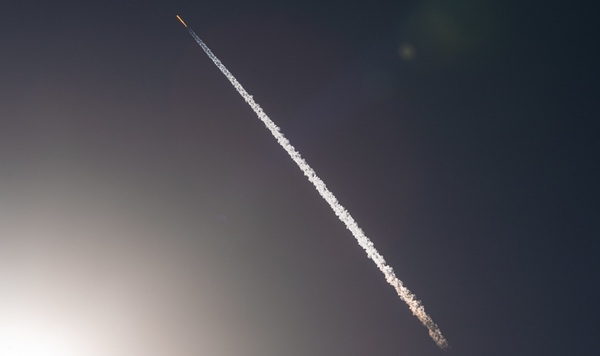 A Falcon 9 heads to orbit. Launch emissions like carbon soot are a concern to some atmospheric scientists as launch rates increase. (credit: SpaceX) |
What is the environmental impact of a supercharged space industry?
by Jeff Foust
Monday, February 6, 2023
There has been a surge in the number of launches, and of satellites launched, in the last several years, thanks to the rise of megaconstellations and less expensive launch options. Last year set a record for orbital launches, with 186 attempts worldwide. This year is on a similar pace, with 16 orbital launch attempts in January alone.
| “The impacts of spaceflight on climate and ozone is growing because we’re looking at this projected increase in the pace of space activity and we’re doing it in a climate-changed world,” said Rosenlof. |
That growth in launch activity has created problems, primarily in space. An increase in the number of satellites, and of debris, poses space sustainability challenges that, in a worst-case scenario, would render some orbits unusable. Megaconstellations like Starlink have raised the ire of astronomers who warn those satellites will interfere with their groundbased optical and radio astronomy observations, leading to ongoing efforts to try to mitigate the problem.
However, launches themselves could create environmental hazards. A growing number of atmospheric scientists are worried that pollution from launches, particularly in the upper atmosphere, could affect atmospheric chemistry and heating. Similar concerns stem from the growing reentries of satellites that, as they burn up, deposit materials that could also affect the upper atmosphere.
“What is done by the space industry in terms of communications satellites and observing the Earth, is indispensable to the economy and it’s providing critical information for us to do climate change research,” said Karen Rosenlof, a research meteorologist at the NOAA Chemical Sciences Laboratory, during a panel at the AIAA SciTech Forum outside Washington January 27. “But the impacts of spaceflight on climate and ozone is growing because we’re looking at this projected increase in the pace of space activity and we’re doing it in a climate-changed world.”
Rosenlof moderated a panel discussion that, for more than 90 minutes, explored the potential environmental impacts of increased launches and reentries. That panel made clear that the magnitude of the problem remains uncertain, which makes it difficult to figure out how to resolve it, including whether new regulations are needed.
Potential impacts
The argument the space industry has typically used to play down environmental impacts is that emissions from launches are infinitesimal compared to other industries, such as aviation. Karen Jones of The Aerospace Corporation’s Center for Space Policy and Strategy noted there are thousands of flights worldwide daily, compared to those 186 orbital launches in all of 2022. Moreover, aviation is just a small fraction of global greenhouse gas emissions. “It’s a sliver of a sliver,” she said of the launch industry’s contributions.
However, not all emissions are equal. Of particular concern is carbon soot from launches, created from vehicles burning kerosene fuel. It is perhaps most recognizable on Falcon 9 boosters, creating a patina that, with each reflight, transforms the booster from its original white to a dark gray.
That soot, or black carbon, can locally heat the upper atmosphere, Rosenlof said, which can affect circulation and radiative transfer, although this overall impact is still not well understood.
| “I cannot imagine any chemical rocket which would be considered to be clean,” Eastham said. “They will all produce emissions of some kind.” |
What is known, though, is that rockets proportionally produce far more black carbon than aircraft, particularly in the upper atmosphere where the fuel is not completely combusted. “A sooty, open-cycle kerosene engine will emit a thousand times more black carbon than a jet engine will at cruise per kilogram of fuel,” estimated Martin Ross, a scientist at The Aerospace Corporation.
Those emissions in the upper atmosphere are problematic because they are long-lived, said Sebastian Eastham, associate director for the Laboratory for Aviation and the Environment at MIT. Launch vehicles, he said, “are going to be depositing black carbon up to arbitrary altitudes,” remaining in the atmosphere for years. “That lifetime alone magnifies their impact by orders of magnitude.”
There is, though, a shift in the industry underway from kerosene to methane. Vehicles like SpaceX’s Starship, Relativity’s Terran 1 and Terran R, ULA’s Vulcan Centaur and Blue Origin’s New Glenn, among others, use methane, which is designed to be cleaner than kerosene, producing less soot.
“Methane is a clean burning fuel. It’s all about where does it come from,” said Jones. Methane produced from renewable energy courses, or even harnessed from landfills, could have far less overall environmental impact than kerosene. “A methane rocket is not such a bad thing.”
Others, though, offered some caveats. “Methane is a cleaner burning fuel. It’s not clean,” argued Gavin Schmidt, director of NASA’s Goddard Institute for Space Studies. Methane, he noted, produces carbon monoxide as a byproduct of incomplete combustion.
“I cannot imagine any chemical rocket which would be considered to be clean,” Eastham said. “They will all produce emissions of some kind.”
At the other end of the space lifecycle is spacecraft reentries, which are increasing as more satellites are launched. That can deposit materials in the upper atmosphere as well, particularly metals.
“We’re seeing an increase in species—specifically, lithium, copper, and aluminum—that can only come from the space industry at altitudes around 20 kilometers,” said Rosenlof, based on high-altitude aircraft measurements taken over the last two decades.
That increase doesn’t appear to be causing “major perturbations” in the upper atmosphere—at least not yet, she said. “However, as spaceflight grows by an order of magnitude or more, we think we’re going to start seeing impacts.”
Measuring environmental impacts
This is not the first time that people raised concerns about the environmental impact of launches. More than three decades ago, some scientists warned that emissions like chlorine from solid rocket motors, like those used on the shuttle and the Titan IV, could damage the ozone layer.
“There were some models that indicated that solid rocket motors would were going to cause a big problem for stratospheric ozone,” Ross recalled. “There were calls back in the 1990s to ban solid rocket motors.”
The US Air Force concluded they did not have enough data on the environmental impacts of solid rocket motors, and asked Aerospace to study it. That led to a campaign of measurements to see how the models compared to reality.
“We got into the plumes, measured the parameters we needed to measure, and determined at solid rocket motors were much less of a problem than some of the models were indicating,” he recalled. “We were able to take solid rocket motors off of the table for regulatory discussions at the time.”
| Schmidt said that NASA would often be asked what effect a launch would have on the environment. “Up until very recently, no one at NASA knew the answer.” |
He and others said that it was time to undertake a similar campaign to measure the effects of launch and reentry emissions on the upper atmosphere. “We can do this,” said Darin Toohey, a professor of atmospheric sciences at the University of Colorado who was involved in those earlier studies. “The trick here is knowing in advance what matters. Back then it was chlorine, but in the future it might be black carbon.”
NASA is starting to look into those issues. Schmidt said that the agency would often be asked, even when launching climate science missions, what effect the launch itself would have on the environment. “Up until very recently, no one at NASA knew the answer,” he said.
During a stint as the agency’s senior climate advisor in 2021, he pushed for a cross-directorate study of launch emissions, bringing together people from human spaceflight, aviation, and Earth science. “We hope to have an actual answer some time soon.”
That initial effort could lead to more detailed studies. “What we’re hoping for is that the work we’re doing here will be a sufficient proof of concept to have NASA and other agencies set up a more structured funding regime to bring in more people and more partners from industry to provide the key information we need,” he said.
Those efforts, Ross said, will likely require in situ measurements of the plumes of some kind, since ground tests aren’t sufficient. “If I tested the black carbon output of an engine on the ground, it’s going to be small,” he said, since the black carbon is consumed in the plume at low altitudes, but not at upper altitude. “Ground testing has a role, but there’s nothing like actually seeing what’s in the stratosphere.”
Jones advocated for what she called an “environmental life cycle” study for spacecraft launches, something she said would be the subject of an upcoming Aerospace white paper. “The lifecycle assessment we propose looks above the Kármán Line as well as below: there’s a lot of terrestrial impacts,” she said. “In doing these lifecycle assessments, you can start to look for efficiencies.”
Technology versus regulation
Any thought of studying launch or reentry emissions triggers fears among some in the industry of impending regulations that would slow its rate of growth or increase costs.
None of the panelists were eager to push for new regulations, saying their interest is in better understanding the impacts of emissions on the atmosphere and find ways to mitigate them. “If we understand the science, that will actually benefit the space industry,” Rosenlof said. “Part of what we want to do is with the people who are developing the technology to have the cleanest technology that is available and promote collaboration and reduce the potential for regulation that may not be desired.”
There have been initiatives elsewhere, though, to reconsider the application—or lack thereof—of environmental law for space activities. For decades, the FCC has excluded satellite licensing from reviews that would be required under the National Environmental Policy Act (NEPA), citing a “categorical exclusion” that concluded that individual satellite launches had no significant impact on the environment.
That exclusion, some believe, no longer applies in an era of satellite megaconstellations that require dozens or hundreds of launches to place thousands of satellites into orbit. Environmental concerns extend beyond launch and reentry emissions to the creation of orbital debris and interference with astronomy.
| “No single agency is given responsibility for spaceflight,” Ross said. “It's a crazy meatloaf of organizations.” |
The Government Accountability Office (GAO), in a report published in November, concluded the FCC needed to review if that categorial exemption still applied. “Without a documented determination from FCC as to whether licensing large constellations of satellites normally has significant effects on the human environment, Congress and the public lack reasonable assurance that FCC’s application of the categorical exclusion remains appropriate for licensing large constellations of satellites in light of technological changes and advances,” the report stated.
The GAO recommended that the FCC reexamine if the categorical exclusion to NEPA applied to satellite megaconstellations and set up a process to regularly review that exclusion. The FCC said it would accept the recommendations, but would wait until a White House body, the Council on Environmental Quality, issued updated regulations for implementing NEPA.
If the categorical exclusion to NEPA no longer applied to licensing satellite megaconstellations or even individual satellites, requiring some level of environmental review, it’s not clear how it might change the design and launch of megaconstellations. “One of the key principles of NEPA is that you have to use the best available science,” said Schmidt. “In a situation like this, the best available science is not very good.” He warned that could lead to lawsuits challenging the quality of the science done for such reviews.
Jones said it’s uncertain how environmental laws would apply to some aspects of space launches. “It’s a huge question in the industry, still.”
Toohey advised caution as well. “What is the proper signal to send to the industry so that we don’t have a disruption?” he asked, referring to changes that new research might cause. “The key here is to think about a framework that’s needed that’s correct for the problem, and try not to adopt another framework which is imperfect but we know how to use.”
Another challenge for environmental law is determining what agency is responsible. In an order in December granting partial approval to SpaceX to launch its second-generation Starlink constellation, it rejected arguments that it needed to perform an environmental review of the launches, concluding that was being done by the FAA, which licenses SpaceX launches. “We have every confidence the FAA has conducted, and will continue to conduct as necessary, thorough environmental reviews of SpaceX’s launch activities and accordingly we incorporate the FAA’s analysis into our own environmental review,” the FCC stated.
Ross blamed the fractured oversight of spaceflight by the federal government, with several agencies holding different responsibilities. “No single agency is given responsibility for spaceflight,” he said. “It's a crazy meatloaf of organizations. At some point, one might wonder if the federal government should develop an agency or sub-agency whose responsibility is space.”
Another regulatory approach could be taxation. Last April, Rep. Earl Blumenauer (D-OR) introduced the Securing Protections Against Carbon Emissions (SPACE) Tax Act that would tax commercial human launches not performing scientific research: $2 million per orbital launch and $100,000 per suborbital launch, as well as a 10% tax per ticket.
“Just as Americans pay taxes when buying airline tickets, billionaires flying into space to produce nothing of scientific value should do the same,” Blumenauer said in a statement announcing the introduction of the bill (which he teased the previous July, just after the first crewed flight of Blue Origin’s New Shepard whose crew included company founder Jeff Bezos.) “I am also concerned about the impacts of recreational space travel on carbon emissions.”
The SPACE Tax Act did not go anywhere in Congress last year, and its future prospects remain uncertain. Jones did not rule out some tax regime, analogous to taxes paid by airline passengers, that could be applied to commercial space. “Maybe some economic model involving a carbon tax could occur,” she said.
A fundamental issue, said Ross, is that industry moves at a different speed from both regulators and scientists. “Megaconstellations are an example of private industry moving much faster than not only regulatory agencies but also faster than professional science societies,” he said. “By the time we write and publish papers, there’s another 2,000 Starlink satellites up. We’re moving along, but maybe not fast enough.”
“It’s an example of technology moving so much faster than society can really respond to,” he added.
Jeff Foust (jeff@thespacereview.com) is the editor and publisher of The Space Review, and a senior staff writer with SpaceNews. He also operates the Spacetoday.net web site. Views and opinions expressed in this article are those of the author alone.
Note: we are using a new commenting system, which may require you to create a new account.
Book Review: The New Guys
 |
Review: The New Guys
by Jeff Foust
Monday, February 6, 2023
The New Guys: The Historic Class of Astronauts That Broke Barriers and Changed the Face of Space Travel
by Meredith Bagby
William Morrow, 2023
hardcover, 528 pp.
ISBN 978-0-06-314197-1
US$40
Other than perhaps the original Mercury Seven astronauts, no astronaut class was more influential than what NASA formally called Group 8, announced in 1978. Until that group, nearly all of NASA’s astronauts were pilots with military experience; all were white men. The 35 members of Group 8—dubbed TFNG for “Thirty-Five New Guys” (with a more explicit alternative)—included the first women and people of color, as well as many more researchers and doctors, as reflecting changing expectations for the spaceflight with the impending introduction of the shuttle as well as a desire, if not an imperative, to have the astronaut corps be more representative of society.
The new book The New Guys by Meredith Bagby examines that historical astronaut class. Given the class’s size, it is not an exhaustive biographical account of every member of the class. Instead, she focuses primarily on those historic members who would become the first female, Black, and Asian American astronauts to go to space.
| When reading the book, one wonders if it had been written with one eye towards turning it into a dramatic series for HBO or Netflix; a For All Mankind about real astronauts. |
The book profiles several of those TFNG astronauts, filling in their life stories as Bagby recounts their decision to apply to become astronauts, the selection and training process, and ultimately flying to space. This is all told against the backdrop of the development of the shuttle program and its problems that would tragically culminate in the Challenger accident; four of the seven people killed were members of that class.
Bagby relies heavily on interviews she performed as well as NASA oral histories and other accounts. The book is filled with passages with reconstructed dialogue from events likely recalled only decades later, along with what she describes in an author’s note as “interior thoughts and feelings” of these people based on her research. “In these cases, I have interpreted how these individuals likely may have thought and felt and represented those thoughts, feelings, and reactions in italics,” she writes. “They have been included to attempt to capture the joy, fear, sorrow, confusion, and excitement felt all throughout the shuttle’s storied history.”
Those thoughts and dialogue do liven up the book, reminding us that these historic astronauts were human beings. It’s unevenly applied, though, as we don’t get the same treatment for most of the other members of the class, including the white male military pilots that would have fit in to earlier astronaut classes. That’s true even among the trailblazing members: while the other five female members of the TFNG are profiled early in the book, we read little about Shannon Lucid until late in the book, when Bagby recounts her extended stay on the Mir space station in the mid-1990s.
That approach does provide the book with dramatic flair. When reading it, one wonders if it had been written with one eye towards turning it into a dramatic series for HBO or Netflix; a For All Mankind about real astronauts.
However, it doesn’t necessarily offer significant new historical insights or revelations about the astronaut class. The book, for example, examines Ride’s same-sex relationships that were not publicly known until after her death in 2012, as well as her behind-the-scenes role in the Rogers Commission investigation of the Challenger accident, but those have been previously reported, including in Lynn Sherr’s excellent biography of Ride (see “Review: Sally Ride”, The Space Review, June 16, 2014).
The New Guys does offer a big-picture view of an astronaut class that reshaped the agency. Recent astronaut classes have approached or achieved gender parity along with greater diversity. They have gone through the door opened, if not built, by the TFNGs.
Jeff Foust (jeff@thespacereview.com) is the editor and publisher of The Space Review, and a senior staff writer with SpaceNews. He also operates the Spacetoday.net web site. Views and opinions expressed in this article are those of the author alone.
Note: we are using a new commenting system, which may require you to create a new account.
